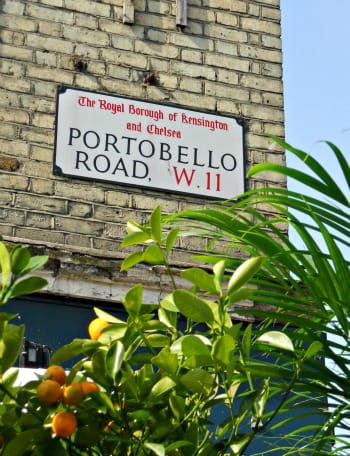
London’s justly famous Portobello Road
Picture the scene: rolling fields, pigs snuffling in a farm yard, cart horses standing bold and proud. A bucolic agricultural idyll, the sort of image of England that makes one go dewy about the eyes with pride. Not the expected image for a blog post on one of the world’s most famed markets, is it? Well, if you’d been looking north along Portobello Road at any point between 1740 and 1862 that is what you would have seen. A farm amidst fields. Before 1740 it would have just been fields.
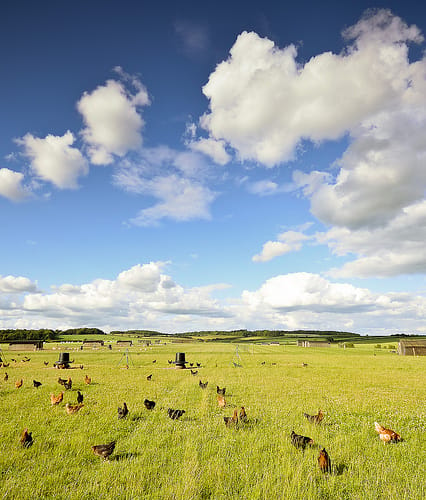
A bucolic country scene … not quite what Notting Hill looks like today
You see, in 1739 us Brits – courtesy of a certain Admiral Vernon – won a spectacular naval battle over the Spanish at a spot called (wait for it…) Porto Bello in Panama. The following year an arable farmer north of London named his farm in honour of this military triumph. And the name stuck.

How Portobello Road was named
Unfortunately for the snuffling pigs and proud carthorses, that was about all that did. With the arrival of the ambitious Victorians in the 19th century, London’s urban expansion began in earnest. In 1862 the Portobello farmhouse was razed to the ground and in 1866 its 170 acres were sold for property development. Some lovely architectural feats were the result in parts of Notting Hill … with some rotten rookeries and slums as the result in others.
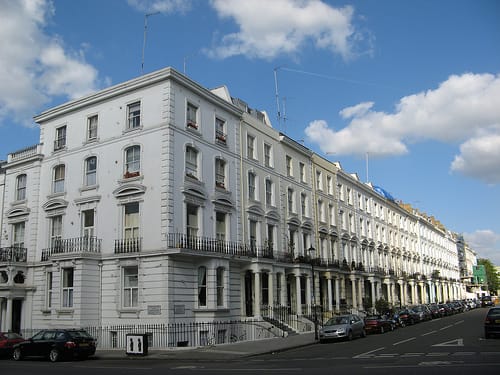
Architectural successes in Notting Hill
Portobello Road was situated between some of the grander edifices that replaced the farmland, a perfect location for market traders to sell their wares – predominantly food produce – to the kitchens of the great houses.
It wasn’t until the 1940s that the rag-and-bone men began to replace the traders. For a somewhat idealized image with accompanying song (and in this particular clip, some helpful subtitles) of what the Market looked like during the Second World War I refer you to Disney’s classic, Bedknobs and Broomsticks.
The seeds were sown for the world famous market that we know of today. Portobello Road has traders on it every day except Sunday … which must be a relief for local residents as Saturday is usually exciting thronging with people. Get there early to bag a bargain, an easy task for those of you who will be staying in one of London Perfect’s Notting Hill properties!
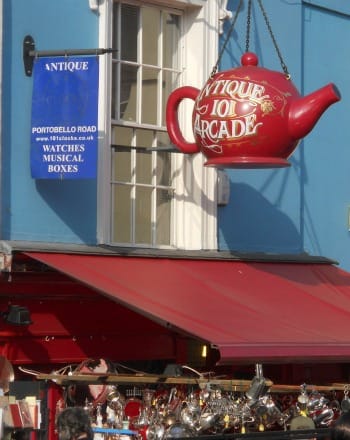
Antiques along Portobello Road
The famed antiques section is closest to Notting Hill Gate tube station, between Chepstow Villas and Elgin Crescent. Its main trading day is on a Saturday. Hence throngs.
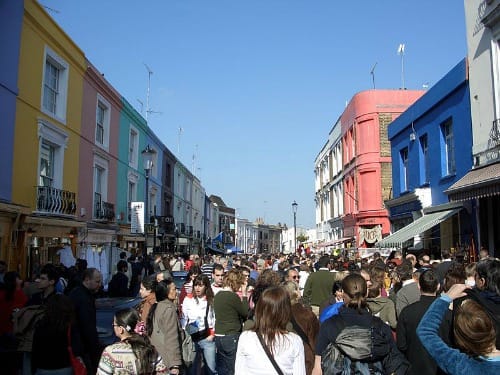
Saturday morning crowds on Portobello Road
However do consider a wander Monday to Friday. You can enjoy the calm and still browse as a number of the permanent antique shops are open and a few independent stallholders are around.
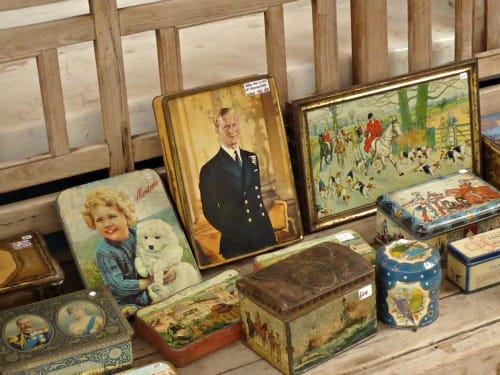
Just who is that handsome devil on the vintage tin? Answers on a postcard, please!
The stretch between Elgin Road and Talbot Road is where the fruit and veg traders congregate here. This would be the stretch to stock up your fridge. You’ll need a good feed to stay strong as you’ve still got the new items and fashion markets between Talbot Road and the Westway. The latter is chock full of vintage treats and crafty delights, just waiting to be discovered.
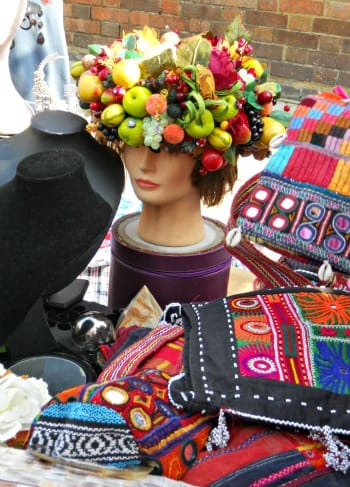
Anything and everything … on Portobello Road!
And if you’re feeling brave and confident to pass off as a proper local then there’s the second hand market between Westway and Goldbourne Road. It’s like a Womens’ Institute jumble sale but you’ll need sharper elbows and be prepared for less tea and victoria sponge cake to fortify your soul.
I’m sure Admiral Vernon – victor of that naval battle in 1739 – could never have dreamed what his triumph at a small Panamanian port would spawn…
_____________
Zoë F. Willis is a London Perfect reservationist, writer and Londoner. Visit her blog Things Wot I Have Made to find out more about Zoë’s many creative talents!
Photo Credits: Country scene by Patrik Jones, The Capture of Puerto Bello by George Chambers Sr., Notting Hill architecture by Olivier Bruchez, Saturday on Portobello Road by Josep Renalias, Vintage tins by Zoë F. Willis, Portobello Road by Garry Knight, all other photos by Laura Thayer.
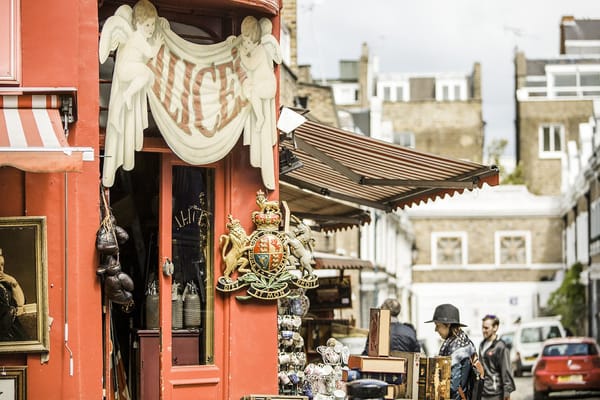

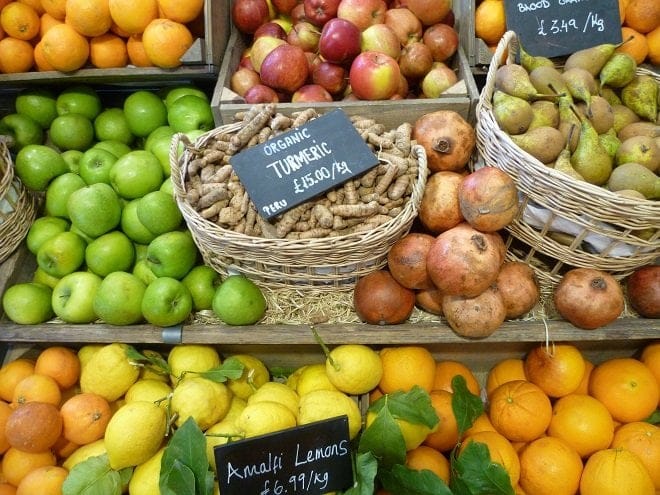
I will be in London for 1 week with my granddaughters, ages 18 and 21. I am a healthy, strong 74 years. Please give me some tips on the best way to see Portabello Market without exhausting ourselves. Other places/events that would be of special interest to the granddaughters would be very much appreciated.
Thank you
Hello Harriet, Thank you for stopping by and commenting! How lovely that you’ll be enjoying London with your two granddaughters! We always recommend getting to the Portobello Road market as early as you can to beat the crowds. There are many cute cafes to stop off and rest along the way over a cup of tea. Your granddaughters will love all the fashion boutiques along Portobello Road, and be sure to explore nearby Ledbury Road and Westbourne Grove for more great shopping in Notting Hill. Oxford Street and Regent Street are a lot of fun, along with Covent Garden and Kensington Gardens. If you all love fashion, do check out the costume displays at the Victoria and Albert Museum. So many fun ideas! Wishing you a wonderful time in London!
I love Portobello road market, it was also very significant for Spanish migration.
Thank you for your comment, Adriana! Notting Hill has such a vibrant and interesting history. I love how you can feel all the different cultural influences while exploring the neighbourhood.